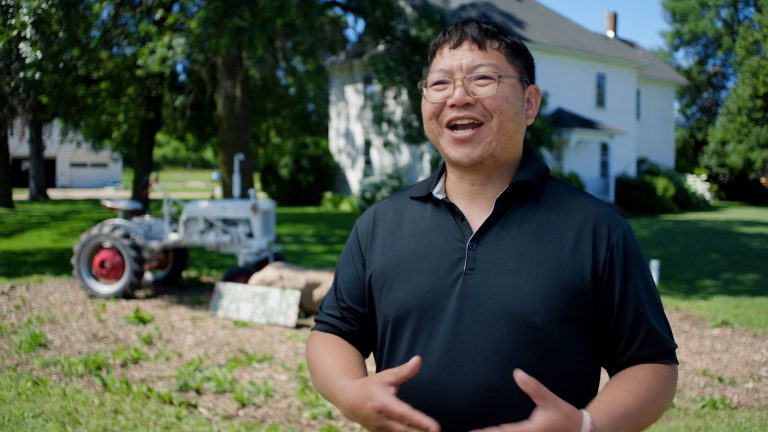
Category:Impact Story8 min read
Category:Impact Story8 min read
In 2020, the City of Ann Arbor took the bold step of committing to reaching carbon neutrality by 2030. “Climate change is real and it’s impacting people today, but we also know that it’s not impacting everyone in the same way,” explains Missy Stults, the city’s sustainability and innovations director. That’s why her team began by asking residents of the city’s frontline Bryant neighborhood what it would look like if they were the most sustainable neighborhood in the country. “They gave us the most beautiful ideas of what’s possible. Then our job just became working with them to make those real,” Stults says.
Today, thanks to residents’ insights and ideas, the Bryant neighborhood—situated on a floodplain flanked by a landfill to the southeast and Interstate 94 to the north—is positioned to become one of the first carbon-neutral neighborhoods in the United States.
“A lot of the residents are on fixed incomes and can’t afford to get the repairs and renovations that they need for their homes to make them more sustainable,” explains Krystal Steward, a Bryant resident and senior outreach specialist for the project with Community Action Network (CAN). Where residents once faced costly-to-mitigate challenges in the form of mold, mildew, and water damage, they’re now enjoying water mitigation improvements alongside the installation of solar panels, the planting of trees, and the swapping of gas appliances for electric alternatives—all solutions identified and led by community members.
“Investing in the neighborhood means a lot to the community as a whole, to know that people are willing to help them,” Steward continues. “I also live in this neighborhood, so to be able to help my neighbors, it means a great deal.”
Video produced by Line Break Media
“They basically put as many resources as they could into fixing the problems of the hardest hit communities before anyone else,” explains Hank Love, vice president of strategy at Elevate, an energy equity non-profit and partner on the project. “That led to a lot of participation and work in the community, starting with meetings about the needs of the community and what they wanted to accomplish.”
It’s this initial step of uncovering what the community truly wants, needs, and would like to see that is a necessary element of climate equity work. Yet, its critical importance is often underestimated and overlooked by the philanthropy community. “Community-based organizations aren’t often given the resources to do [front end engagement] work. It’s often considered to be on their own dime, and there’s an inequity in that,” Love explains.
Stemming from a core belief behind their Midwest Climate & Energy program—that the “choice” between addressing the climate crisis and advancing equity and justice is a false one—McKnight Foundation provided early seed funding to Ann Arbor’s Community Action Network. This frontend support allowed the group to effectively engage residents and ground the city’s climate mitigation efforts in the needs of Bryant residents.
“One of the big challenges for this kind of work is finding the resources to continue to do it,” says Derrick Miller, CAN’s executive director. “We would literally not be at this point in this work without that initial investment from the McKnight Foundation.”
McKnight sees an opportunity for more funders to join them in filling that gap. “We know that philanthropy as a sector has been slow to support the kind of patient, time-intensive work of actually engaging community members,” explains Ben Passer, senior program officer for McKnight’s Midwest Climate & Energy program. “We were able to provide an opportunity for CAN to ask residents about the kinds of concrete things they want to work toward in that specific community.”
Community engagement support also helps organizations to be better positioned to secure and maximize additional sources of funding, including federal dollars flowing from the Inflation Reduction Act. When communities can first take the time to self-determine solutions to their self-defined problems, organizations like CAN are then able to make a compelling case for the good they can do with the additional funding necessary for turning those ambitions into reality.
“Our early support has helped Community Action Network secure what’s now up to a million dollars over the last year from the Michigan State Housing Development Authority. That million dollars is really supporting a lot of the direct improvements that are being made to Bryant homes,” Passer says.
In addition to equipping Bryant residents to better weather the climate challenges that lay ahead, the home improvements are immediately reducing energy cost burdens. “Before the solar panels, I was paying $145 a month. This month it was $24,” says Deborah Pulk, a Bryant Neighborhood resident and program participant. “It’s made a big difference in my electric bill.”
“For folks at the lowest income levels or who are on fixed incomes, energy burdens can be as high as 30% or more of their income,” Passer notes. “If we’re thinking about how people are able to live comfortably related to issues like quality of housing and intersectional issues like health, the more we’re investing in efficiency and reducing folks’ energy burdens, the more we’re also improving their health directly and in the long run. It’s a really powerful way for us to think about energy equity regardless of geography.”
Ultimately, Passer explains that the Bryant neighborhood project provides a model for how decarbonization efforts can be catalyzed through community engagement and “really move an entire community and hopefully an entire state towards its decarbonization goals.” Passer continues, “With bold, strategic investments, we can multiply successes like Ann Arbor across thousands of cities in the Midwest. We can build the capacity of diverse, local actors to absorb and deploy new capital while making the Midwest a global hub for innovation and the rapid, equitable implementation of climate solutions. We’re excited to have other philanthropic partners coming in to support this work, and we hope that more folks will continue to join us going forward.”